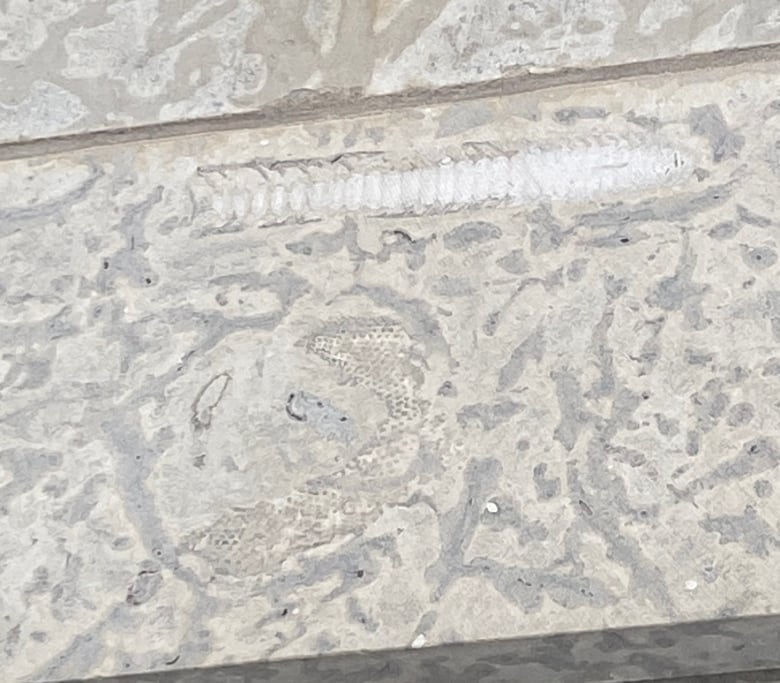You rock, Manitoba limestone! Iconic building material gets global heritage designation | CBC News
A building material used in Manitoba for nearly 200 years, from trading forts to the modern-day architecture of the Canadian Museum for Human Rights, now has international recognition on par with Carrara marble used in ancient Rome.
Tyndall Stone — a fossil-laden limestone dating back 450 million years — has been designated as a global heritage stone resource by a subcommission of the International Union of Geological Sciences.
The cream-coloured stone often has a tapestry-like mottling from marine organisms that lived at the bottom of a tropical sea that once covered the area, making it a popular feature in architecture.
Canada is the only source in the world for the stone, and Manitoba is the only place it is quarried.

“It’s an honour. We’ve always said it’s not like other limestones. There are other limestones in Canada, but this is a unique deposit, and the fossilization is really different,” Donna Gillis, fourth-generation co-owner — along with her brother Keith — of the Gillis Quarries in Garson, Man., about 25 kilometres northeast of Winnipeg.
“We’ve got that as being something special,” she said about the mottling.
Founded in 1910 by August Gillis, the family-operated quarry is the only one in the world mining the stone. There were a handful of others — all in Garson — but the Great Depression claimed most while others retired. Gillis then acquired the properties.

Tyndall Stone was discovered in 1823 by Hudson’s Bay Company employees who first noticed an exposure along the banks of the Red River near Selkirk.
The stone was first used to build the warehouse and walls of the HBC’s Lower Fort Garry in 1832 and St. Andrew’s Anglican Church in 1845, both of which remain standing and in use.
But it wasn’t until 1894 that the major deposit was discovered in Garson by a farmer who hit an impenetrable layer while digging a well. The first large quarry opened in 1898, and the stone got its name because rail shipments were sent from the nearby community of Tyndall.
The name is now trademarked by Gillis Quarries.

August Gillis first became involved by cutting the stone in a small shop in Winnipeg in 1910, before buying a Garson quarry in 1915.
The stone can now be found in buildings across Winnipeg — the legislative building, the former Hudson’s Bay store downtown, city hall, the Manitoba Museum, Winnipeg Art Gallery, the Law Courts, Westminster United Church, Union Station, St. Boniface Cathedral, the Civic Auditorium and many more.
It really is a signature of the city, said Graham Young, curator of geology and paleontology at the Manitoba Museum, who spearheaded the nomination along with Brian Pratt, a geology professor at the University of Saskatchewan.
“It’s great to get some recognition for Tyndall Stone on the world stage. It’s been such a significant stone across Canada and the building of this country,” he said.

It’s not uncommon to see people pointing out fossils in the stone on buildings or stair slabs made of Tyndall. But it’s equally special for those mining the stone, said Gillis.
“When you’re cutting into a solid piece of stone, you don’t know what you’re going to find. It’s a mystery,” she said.
“We might hit something like, wow, this is really different, this is quite amazing. And then there’s some we’ve seen before, but you always see them in different ways, different angles, different orientations in the stone.”
Outside of Manitoba, the stone has been used for the Parliament Buildings in Ottawa, the Canadian Museum of History in Quebec, the Saskatchewan Legislative Building, Banff Springs Hotel in Alberta and the Empress Hotel in B.C.
Overseas, it is in Canada House in London, England, the Canadian Embassy in Berlin, and private homes in Australia and Japan, Gillis said.
“That’s one of the reasons it did make it on the global heritage stone resource list, because it has had widespread use and can be used in a variety of ways,” she said, noting she reviewed the submission before it went to the committee.

Tyndall Stone is the only Canadian stone on the worldwide list, which contains 32 stones designated as heritage resources.
“This designation provides recognition to dimension stones that have broad significance to humanity,” a news release about the designation says.
Young hopes the designation also helps to underscore, for Manitobans, “how lucky we are to have Tyndall Stone, what an interesting material it is and how important geology is to our everyday lives.”

While the designation might not lead to a rush of new orders, it will probably pique the interest of fossil hunters, Gillis said.
“We already have more paleontologists and geology people that, when they’re often on vacations, they like to come and stop in and see if they can kind of take a look around, because it is very intriguing,” she said.
Thanks to that access, the Manitoba Museum has built a significant collection of fossils that are used for scientific research, exhibits and programs, Young said.
“There are actually a lot of scientific papers have been published that deal either directly with Tyndall Stone fossils or that include Tyndall Stone as as an important example when understanding ancient environments.”

For all the latest Technology News Click Here
For the latest news and updates, follow us on Google News.

